(Important Disclaimer: There are places where ice forms many feet thick and travel on frozen lakes is perfectly safe for a good part of the season. In other places, especially during a winter like this one, ice conditions can change from day to day, even hour to hour.
The strengthening sun creates soft spots as melt water collects in the dips between expansion cracks, and a route that was safe in the morning merits a second look after lunch. Faint tracks mark yesterday’s trail, which puddled up and froze over last night, leaving a thin veneer over a foot of nothing but slush and at least a bracing dunk.
If asked, Quill Gordon will tell you no ice is safe, but if you do find yourself crossing a frozen lake, check ice thickness often and be aware of changing conditions.)
¦¦¦¦¦
An overnight skiff of snow on the ice is like a clean slate. Any tracks or other signs of activity I see are recent, laid down only hours before my morning rounds. Otters, mink and squirrels are common, and I saw the tracks of a fisher cat last week but, far and away, the most common tracks I come across are those of coyotes.
It’s the time for pairing off and denning up, asserting dominance and proving worth, and the coyotes have been plenty active. Most are travelling in pairs, but a big, lone male has also been out and about.
Rain and mild temperatures at the end of January turned what snow we had to ice and conditions have been treacherous. Slip and fall injuries have been common in these parts lately and, even if the fall is averted, the slips can be painful. I suspect our lone male suffered just such a slip, causing him to drag a right foot and giving him a very distinctive track.
Open water is a draw, allowing mink and otter access to food such as crayfish. It is not uncommon to come across the remains of their meals at springs, seeps, and the mouths of feeder streams.
A leisurely snack in the predawn chill might seem as good as it gets to an otter or mink, but they are not the only creatures aware of the food potential of these spots. In the space of an instant, the eating can become the eaten, as an ambush is sprung or a mad rush pays off.
Three nights ago, two coyotes, working together, waited for an otter to dive for another tasty morsel, pouncing when she returned to the mouth of the stream (I am guessing female because a very large male is still making the rounds, right now working the drainage below the house). They pulled, dragged and chased the otter away from the opening, toward the other shore, where she didn’t stand a chance in the end, but it was quite a scrap while it lasted. The commotion was enough to attract the attention of a third coyote, the lone male with the limp.
It was a chaotic scene, with three coyotes fighting for posession of an otter fighting for its life. Tracks and skid marks mingled as the fight raged, and blood spread across the snow, fading to yellow in the faint warmth of the morning sun. Other than tracks by the stream and some stains in the snow, the only signs of the otter that I could find were a few small clumps of fur and one small leg bone, dropped in the scuffle as someone tried to eat on the run.
I followed all three sets of coyote tracks out of the cove, behind an island, and toward the north. One set was small, a female, and the other two were large, both males, including the gimpy loner.
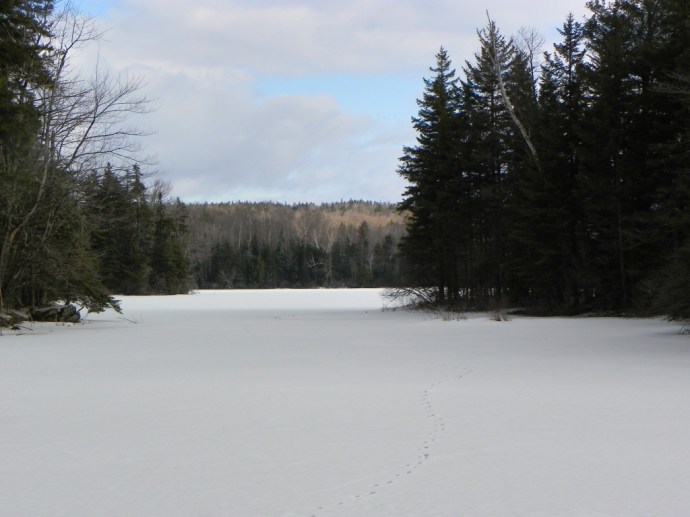 The two males moved side by side, bumping and slipping as they went. Faded blood drops showed every twenty feet or so, leading me to believe one animal was injured.
The two males moved side by side, bumping and slipping as they went. Faded blood drops showed every twenty feet or so, leading me to believe one animal was injured.
 Another scuffle ensued and the two sets of large tracks diverged, with the gimpy male eventually heading west. The blood drops stayed with the other male, fading as they went, and I started to think he was carrying what was left of the otter as he veered to the northeast.
Another scuffle ensued and the two sets of large tracks diverged, with the gimpy male eventually heading west. The blood drops stayed with the other male, fading as they went, and I started to think he was carrying what was left of the otter as he veered to the northeast.
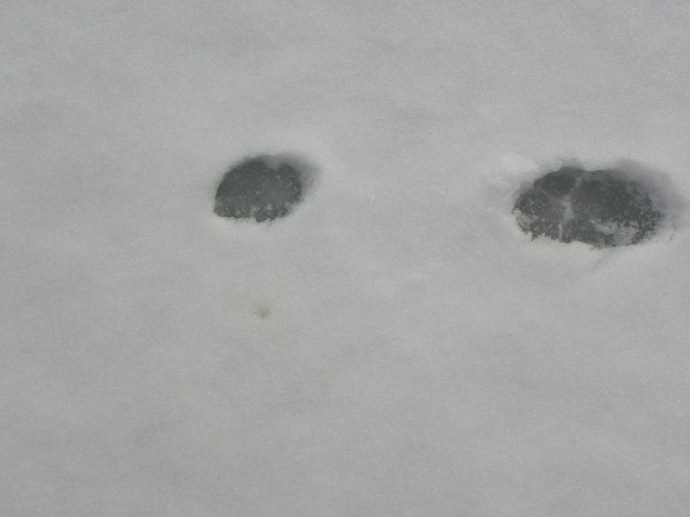 The small female pursued the gimpy male to the near shore before turning east and intercepting her mate. There was nothing oblique about the angle as these two met which I took to be the approach of a familiar, comfortable pair.
The small female pursued the gimpy male to the near shore before turning east and intercepting her mate. There was nothing oblique about the angle as these two met which I took to be the approach of a familiar, comfortable pair.
Together, the two of them trotted across the lake, their battered prey in tow, eventually leaving the ice and heading over the hill to their (newly discovered) den at the base of a blown down tree on the edge of the swamp.
Two coyotes got away with at least most of their kill, while another limped off in search of an easier meal. The next morning, signs of the pair’s success were scattered around in the form of greasy turds, showing bone chips and hair.
Coyotes are adaptable, resourceful, and opportunistic, so the male with the limp most certainly did not go hungry.
He’s been down behind the barn, digging through the snow beneath the apple trees, getting drunk on rotten fruit and maybe scarfing down the occasional mouse. The scat he leaves behind shows the result of his fruit-heavy diet.
Coyotes in Vermont can be shot, day or night, any time of year, so they tend to be skittish and sightings around here are rare, especially with our thick woods. Their tracks and signs always tell stories, just as those of otter and mink, but it is only on the ice that I have seen those stories played out from beginning to end, and the most obvious lesson I take away from these encounters is that life in the woods involves a lot of death.
That, and I’m not the only gimpy old guy who appreciates the therapeutic benefits of fermented fruit from time to time.
(Eastern coyotes tend to be larger and heavier than their western cousins. Various theories as to why have been discussed over the years, including hybridization with dogs. Thanks to modern DNA technology and the cooperation of hunters and trappers, we know hybridization is indeed the difference, but it was not with domestic dogs. According to the feature article in the Fall, 2010, issue of Vermont Furbearer Management Newsletter, some populations of western coyotes moved through Canada on their way east, where they interbred with Timber Wolves, creating something in between the two.)
¦¦¦¦¦
More adventures on a frozen lake, from November, 2010: On Thin Ice


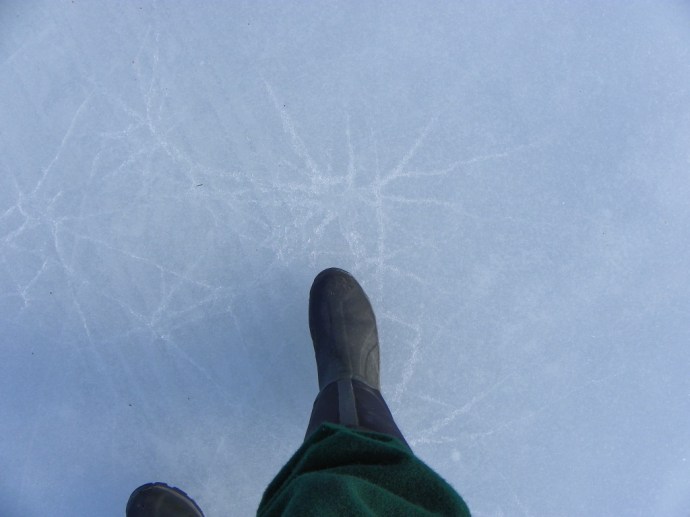

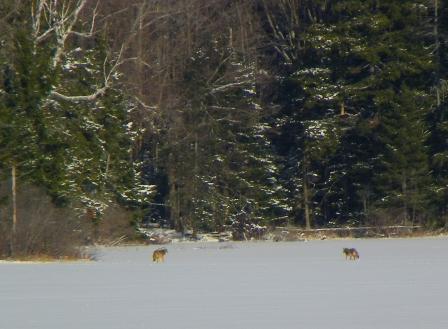

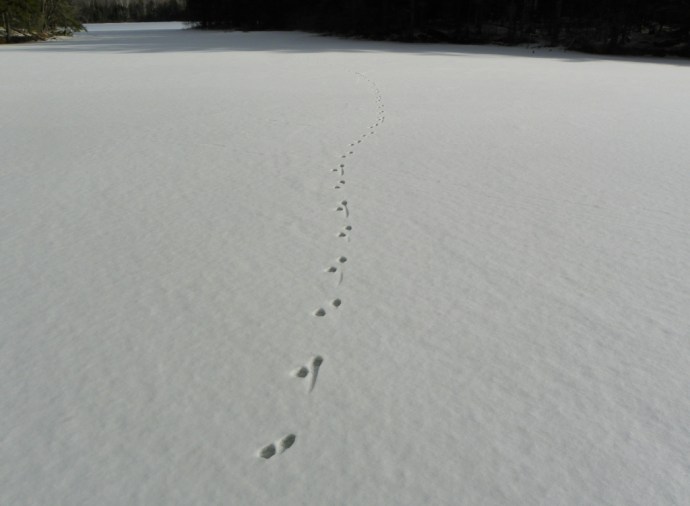

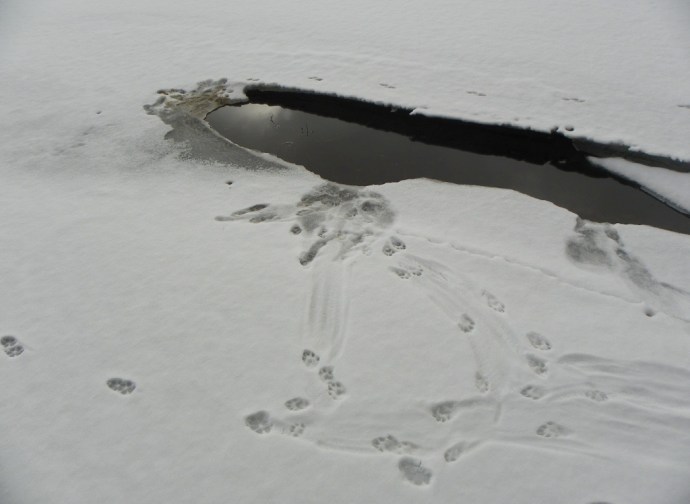


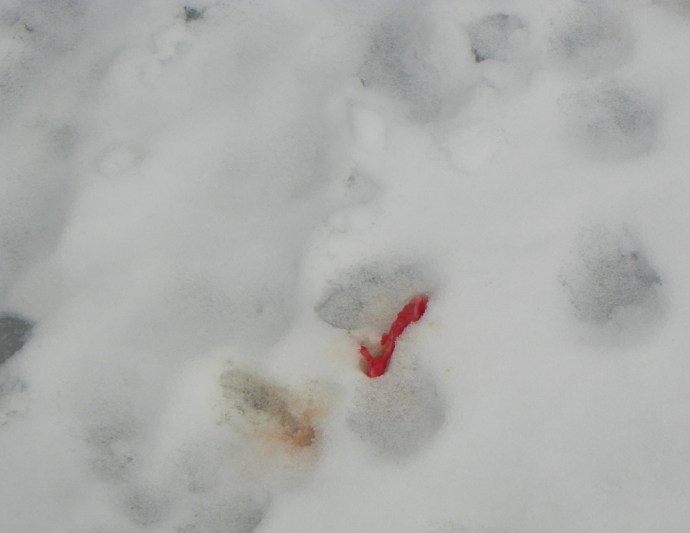





That was intriguing. I wonder if any of the blood came from the coyotes. The otters I’ve seen weren’t all that small and I recall seeing a fair amount of teeth and claws.
That last shot definitely looks a bit wolfy. I have one dog that has gray markings like that. She was a rescue dog and it was rumored she was part wolf. No wonder she gives me that look like I’m just another food source.
An otter would certainly put up a hell of a fight. I doubt very much that a single coyote would take one on, especially with the woods so full of bunnies, mice and other, easier, pickings. This pair had the advantage from the start, beginning with the element of surprise. With two coyotes, I have a feeling it was over pretty quickly, especially with the competition on the way. Even the hungriest coyotes would think twice about taking on the big male otter I’ve seen; he is a brute and the results would have been much different, I’m sure.
You’ll be okay with your wolf-dog as long as you keep that kibble coming. I think.
You live in a most beautiful place, and that drama read off the tracks was just an amazing story. Very well done!
Thank you, my french-speaking friend! These things happen all the time but we don’t get to see the signs very often. One more reason to always carry a camera!
Wonderful story, Quill. All the elements of great drama; action, blood, love and crap!
Thanks, Steve. I am glad my life is not as dramatic as what I see in the woods and on the ice. I found the den this pair is using and I’d like to get closer for photos but I’m afraid of the drama that might ensue, leaving someone else to figure out the boot prints, blood, and scraps of green wool everywhere …
Lucky you for living so close to these elements and having the faculties for relating the drama on ice. Reminds me of the true-life tales told by Ernest Thompson Seton, stuff I used to read long ago.
Walt, I need to dig up some Seton — haven’t read anything by him in a long time. In some ways, stories like his seem old and outdated because so few people can relate to the activities that get one out where this sort of action takes place, but it goes on all the time. In this case, it happened in my “back yard” but a half hour after I got off the ice I was roughing it in line at the grocery store with a gallon of milk, some ice cream and a 12-pack of beer.
…with a gallon of milk, some ice cream and a 12-pack of beer.
Breakfast of Champions.
Only because they were all out of fresh otter.
Fascinating, entirely!
And the warm sun erased it all that afternoon, leaving nothing but some dimples in the ice. I don’t think I would have come up with a story like this on my own, but there it was, plain as day, for just a few hours.
It is amazing that you can see the left overs and probably come pretty close to the true life story. Well done Quill.
It’s all in the timing, I guess. There was not much left to see the next morning so I almost missed it completely. Fortunately, this little episode was spelled out for me, big and bold, over a half-mile of new snow. Usually, I’m connecting faint scuff marks through the trees or seeing nothing. I’m glad you liked it.
fantabulous story i much-much enjoyed ! thanks Quill.
I am glad-glad you enjoyed it, Marc! In just a couple of months I’ll be fishing where this took place!
Just yesterday I came across a young bobcat dead on the ice. He (or she) couldn’t have weighed more than 10 pounds. Coyote tracks all around, but I don’t believe they were witness to his death, just the cleanup.
Still I’ll take bad day in the woods over a good day in town.
I didn’t know there was such a thing as a good day in town.
I can only mirror others comments; great story and observations.
It often amazes me that so much of what goes on in nature passes so many people by; they are oblivious to the often titanic struggle that goes on often just for survival. A bit of a dramatic comment I know but I suppose it all depends on perspective.
Quill…this was great. I have been lax in reading your stuff lately, been very busy and traveling. But it was fascinating, from one who always loves to see and at times, try to interpret tracks in the snow. What a compelling revelation from the tracks. Incredible story, how fortunate that the timing was right for you to catch this natural event in the lives of wild animals. Good stuff!
Pingback: Closing Up | The View from Fish in a Barrel Pond